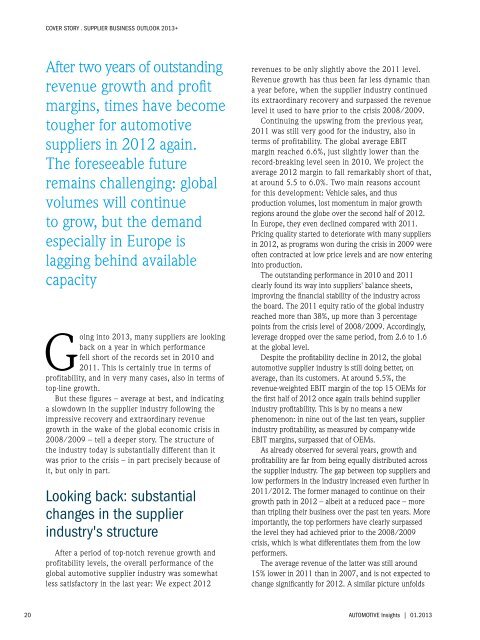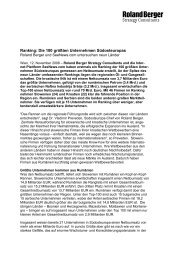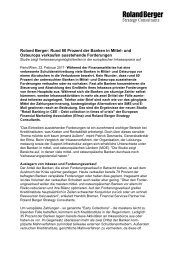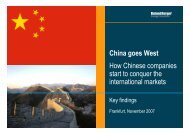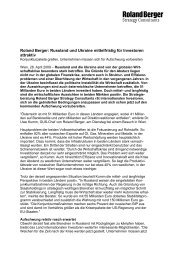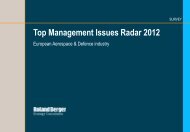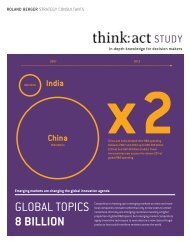Automotive Insights 01.2013 - Roland Berger
Automotive Insights 01.2013 - Roland Berger
Automotive Insights 01.2013 - Roland Berger
Create successful ePaper yourself
Turn your PDF publications into a flip-book with our unique Google optimized e-Paper software.
Cover Story . Supplier Business outlook 2013+<br />
After two years of outstanding<br />
revenue growth and profit<br />
margins, times have become<br />
tougher for automotive<br />
suppliers in 2012 again.<br />
The foreseeable future<br />
remains challenging: global<br />
volumes will continue<br />
to grow, but the demand<br />
especially in Europe is<br />
lagging behind available<br />
capacity<br />
Going into 2013, many suppliers are looking<br />
back on a year in which performance<br />
fell short of the records set in 2010 and<br />
2011. This is certainly true in terms of<br />
profitability, and in very many cases, also in terms of<br />
top-line growth.<br />
But these figures – average at best, and indicating<br />
a slowdown in the supplier industry following the<br />
impressive recovery and extraordinary revenue<br />
growth in the wake of the global economic crisis in<br />
2008/2009 – tell a deeper story. The structure of<br />
the industry today is substantially different than it<br />
was prior to the crisis – in part precisely because of<br />
it, but only in part.<br />
Looking back: substantial<br />
changes in the supplier<br />
industry's structure<br />
After a period of top-notch revenue growth and<br />
profitability levels, the overall performance of the<br />
global automotive supplier industry was somewhat<br />
less satisfactory in the last year: We expect 2012<br />
revenues to be only slightly above the 2011 level.<br />
Revenue growth has thus been far less dynamic than<br />
a year before, when the supplier industry continued<br />
its extraordinary recovery and surpassed the revenue<br />
level it used to have prior to the crisis 2008/2009.<br />
Continuing the upswing from the previous year,<br />
2011 was still very good for the industry, also in<br />
terms of profitability. The global average EBIT<br />
margin reached 6.6%, just slightly lower than the<br />
record-breaking level seen in 2010. We project the<br />
average 2012 margin to fall remarkably short of that,<br />
at around 5.5 to 6.0%. Two main reasons account<br />
for this development: Vehicle sales, and thus<br />
production volumes, lost momentum in major growth<br />
regions around the globe over the second half of 2012.<br />
In Europe, they even declined compared with 2011.<br />
Pricing quality started to deteriorate with many suppliers<br />
in 2012, as programs won during the crisis in 2009 were<br />
often contracted at low price levels and are now entering<br />
into production.<br />
The outstanding performance in 2010 and 2011<br />
clearly found its way into suppliers' balance sheets,<br />
improving the financial stability of the industry across<br />
the board. The 2011 equity ratio of the global industry<br />
reached more than 38%, up more than 3 percentage<br />
points from the crisis level of 2008/2009. Accordingly,<br />
leverage dropped over the same period, from 2.6 to 1.6<br />
at the global level.<br />
Despite the profitability decline in 2012, the global<br />
automotive supplier industry is still doing better, on<br />
average, than its customers. At around 5.5%, the<br />
revenue-weighted EBIT margin of the top 15 OEMs for<br />
the first half of 2012 once again trails behind supplier<br />
industry profitability. This is by no means a new<br />
phenomenon: in nine out of the last ten years, supplier<br />
industry profitability, as measured by company-wide<br />
EBIT margins, surpassed that of OEMs.<br />
As already observed for several years, growth and<br />
profitability are far from being equally distributed across<br />
the supplier industry. The gap between top suppliers and<br />
low performers in the industry increased even further in<br />
2011/2012. The former managed to continue on their<br />
growth path in 2012 – albeit at a reduced pace – more<br />
than tripling their business over the past ten years. More<br />
importantly, the top performers have clearly surpassed<br />
the level they had achieved prior to the 2008/2009<br />
crisis, which is what differentiates them from the low<br />
performers.<br />
The average revenue of the latter was still around<br />
15% lower in 2011 than in 2007, and is not expected to<br />
change significantly for 2012. A similar picture unfolds<br />
20 <strong>Automotive</strong> <strong>Insights</strong> | <strong>01.2013</strong>


